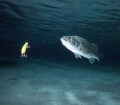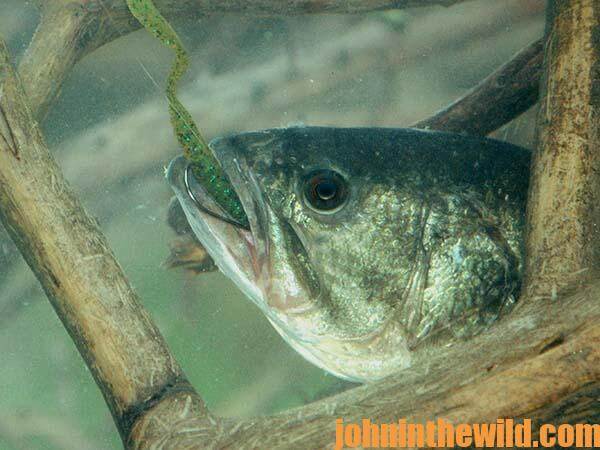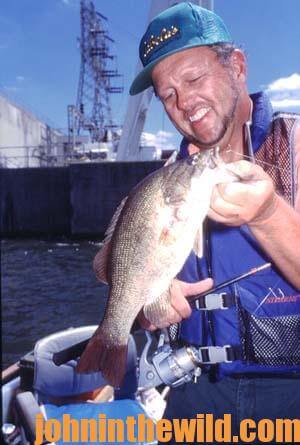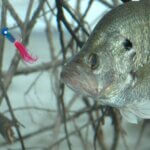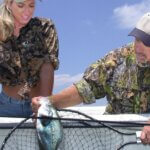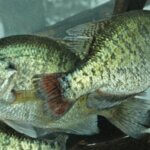John’s Note: Quite possibly the most versatile bass lure ever created, the plastic worm belongs in every angler’s tackle box. His daddy was oil. His mother was heat, and his mentor was a fisherman. He swam into the world of bass fishing years ago and left such a definitive mark on the sport that no angler would consider searching for bucketmouths without him. Many sportsmen believe he is the most lifelike bait around, and some say he has the most action of any lure. And most agree that when bassing is tough, the plastic worm is the weapon on which you can rely to catch bass. Study these tactics to learn more about how the worm is bringing bass to the boats for the pros.
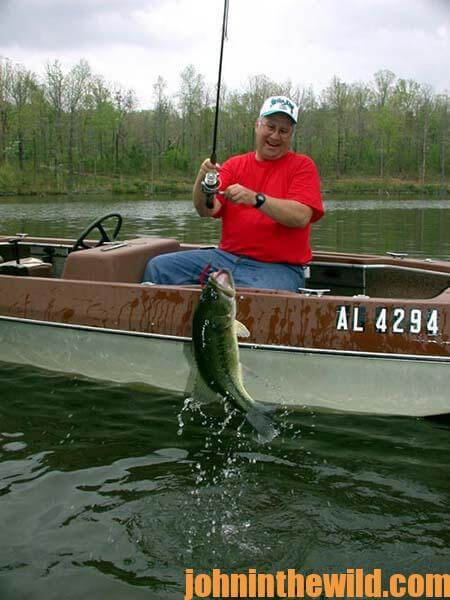 The Texas Rig – Old Reliable:
The Texas Rig – Old Reliable:
Adding a bullet sinker to the line, threading a plastic worm on a hook and then sticking the point of the hook back into the worm, so that it becomes weedless is known as the Texas rig. No one really knows why this particular system of worm fishing became known as the Texas rig, other than professional fishermen in Texas learned to rig a worm this way and caught numbers of bass in tournaments using this system. The Texas rigged worm is quite possibly the most universally accepted method of angling this particular bait. The main reason is that the Texas rig produces bass in hot weather, cold weather, spring, summer, clear water, dingy water, rising water, falling water, thick cover, no cover, water weeds and on rocky points, mud flats and sandy bottoms. I can’t think of any place where a bait can be cast that the Texas-rigged worm won’t catch a bass.
Many anglers fish the Texas-rigged worm on a 5-1/2 foot baitcasting rod and a baitcasting reel that has a 5:1 gear ratio. The common tactic when fishing the worm is to cast it out, let it fall to the bottom, drag or bounce it across the bottom, retrieve the slack in the line and then pull the worm again. There are some fishermen who hop the worm across the bottom, and other sportsmen who cast the worm to cover and then let the bait fall through the structure.
Professional fishermen probably catch more bass using the Texas-rigged worm than the weekend angler does, because the pros target-fish the bait. By this I mean they decide where the bass should be holding on the cover, they cast just past the target, retrieve the lure through the target zone, then quickly retrieve the bait and cast again. The weekend fishermen will cast past the target, retrieve through the strike zone and continue to fish the worm all the way back to the boat. Therefore, the weekend angler will make fewer casts to productive areas during the course of his day. There are always exceptions to every rule. One exception is fishing rip rap. When fishing this type of rocky cover, for the most success, cast the worm to the rip rap, and hop the bait all the way down the rocky bank. When you are fishing rip rap, your bait actually will stay in the water longer and work more structure than when you are target fishing visible cover. If you never learn any other technique for fishing the plastic worm, then the Texas rig will be your best method to master.
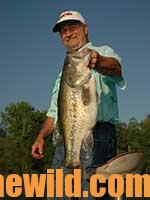 The Do-Nothing Worm:
The Do-Nothing Worm:
Today many lure companies make do-nothing worms. But in August 1985, Jack Chancellor of Phenix City, Alabama, proved that if you do nothing with a worm, you can catch bass by winning the Bassmaster Classic that year fishing his Do-Nothing worm. The Do-Nothing tactic generally uses 17 pound test line, a 1 ounce bullet type sinker, a red plastic bead, a barrel swivel and a 5 foot piece of lead line in 6, 8, or 12 pound test, depending upon the type of water being fished. The lead is put on the line first with the plastic bead threaded right below the lead. Most bass fishermen use a 7 foot flipping stick with a baitcasting reel.
According to Chancellor, “I fish the lead and not the worm. I either drag or hop the lead across the bottom like I will a jig and pig. The worm floats-up behind the lead and comes through the water so slow and easy that a bass just can’t resist the bait. But when the bass bites, because there is so much slack in the line, you won’t feel a violent strike like you will on a crankbait or other type of lure. The only pressure you may notice is what you expect to feel when the lure picks up a leaf. Therefore, don’t rear back to set the hook. Since my Do Nothing lure has small bream hooks embedded in the plastic, a hard hook set may straighten the hooks or tear the fish’s mouth. Instead net the bass when you get it alongside the boat, which is when most anglers will miss the bass. They try and net or lip the fish while it still has too-much fight left in it. So, play the bass into submission, and then net it.”
The most-productive areas to fish the Do Nothing worm are mud flats, rocky points and eddy holes on the backsides of points.
On the mud flats, I believe the bass can see the mud trail that the lead leaves and will follow it to attack the bait,” Chancellor mentions. “When that big lead in front of the Do Nothing worm is scrubbing the bottom in rocky areas, I think the sound draws the fish to the lure.” However, whatever the reason, many anglers have proved that the bass will come to eat the little Do-Nothing worm, and also that anybody can fish it.
To get “How to Win a Bass Tournament: Personal Lessons from 8 Pro Bass Fishermen,” “Reelfoot Lake: How to Fish for Crappie, Bass, Bluegills and Catfish and Hunt for Ducks,” “Catch the Most and Biggest Bass in Any Lake: 18 Pro Fishermen’s Best Tactics” and “How to Bass Fish Like a Pro,” click here.
About the Author
John Phillips, winner of the 2012 Homer Circle Fishing Award for outstanding fishing writer by the American Sportfishing Association (AMA) and the Professional Outdoor Media Association (POMA), the 2008 Crossbow Communicator of the year and the 2007 Legendary Communicator chosen for induction into the National Fresh Water Hall of Fame, is a freelance writer (over 6,000 magazine articles for about 100 magazines and several thousand newspaper columns published), magazine editor, photographer for print media as well as industry catalogues (over 25,000 photos published), lecturer, outdoor consultant, marketing consultant, book author and daily internet content provider with an overview of the outdoors.


